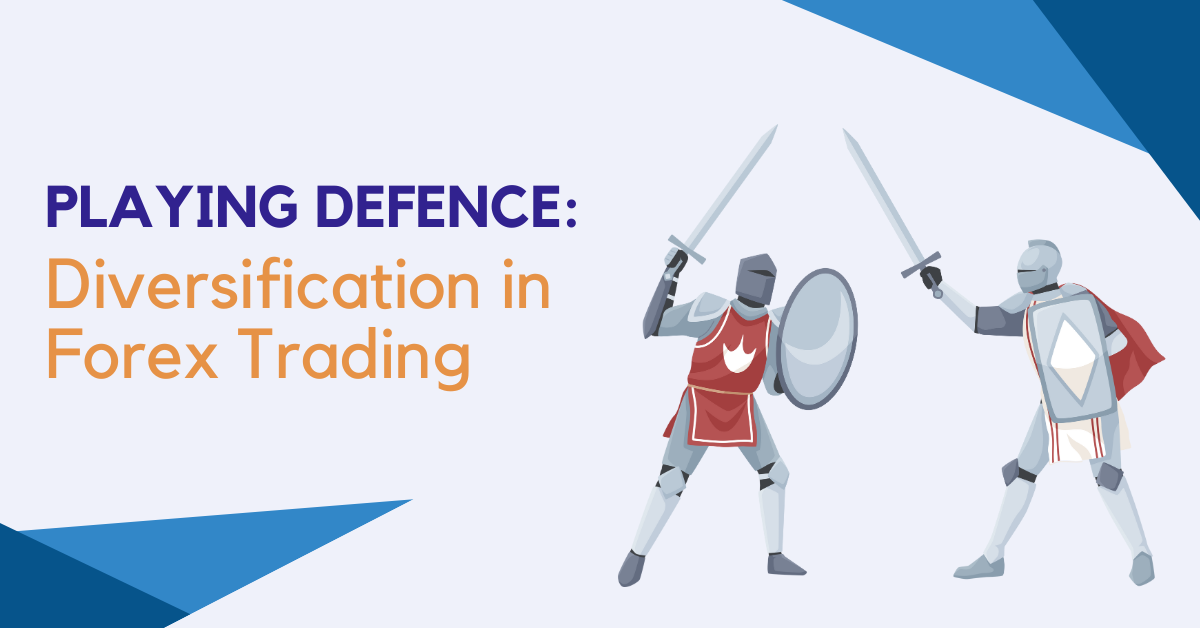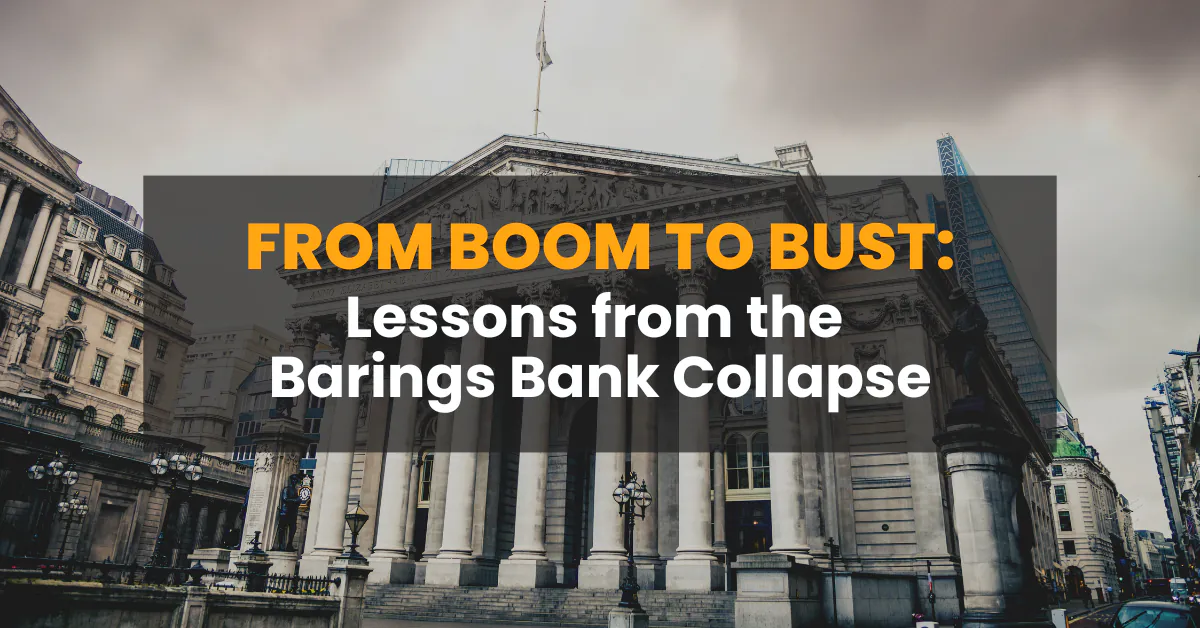What is CFD? With 2 Practical Examples
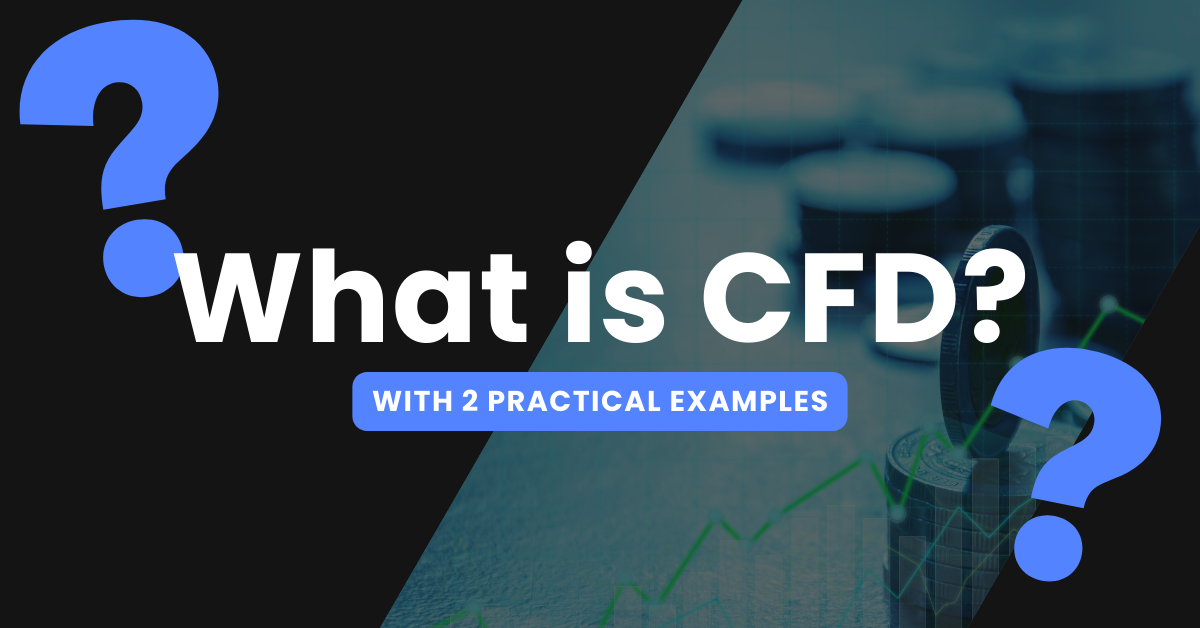
Chua Minghan, CFA | Senior Manager, Dealing
Chua Minghan graduated from the National University of Singapore with a Bachelor’s degree in Economics. He is passionate about education and went on to get a post-grad Diploma in teaching. His vision is to educate clients to make informed decisions for their trading and investments.
Minghan enjoys learning fundamental analysis, technical analysis, and strives to use data analysis to improve his trading skills.
In this article, you will learn what CFD (Contract for Difference) is, the costs and benefits of trading CFDs, and two practical examples of trading CFDs in Singapore.
Meaning Of CFD

Source: Freepik.com
CFD stands for Contract for Difference. It is a derivative that allows traders to speculate on the price movements of an underlying asset, without actually owning the asset itself. CFDs are traded on margin, which means that traders only need to deposit a small amount of capital to open a position.
This makes CFD trading a relatively accessible way to trade the financial markets, even for those with limited capital.
Costs Of CFD Trading

Source: Freepik.com
When trading CFDs, there is a transaction cost, and a finance charge also known as a cost for holding a position overnight.
For example, assuming DBS is currently trading at S$30 and you want to buy 1000 shares. This means the total contract is valued at S$30,000.
Assuming the margin requirement is 10%, with commission at 0.1% with a minimum charge of S$15 and a finance charge of 6.75% you would have to pay the following:
| Margin Requirement (10%) | S$30,000 * 10% = S$3,000 |
| Commission (0.1%, min. S$15) | S$30,000 * 0.1% = S$30 |
| Finance Charge | S$30,000 * 6.75% / 365 = S$5.55 |
On the other hand, if you were to trade using stocks, 1000 shares of DBS would require you to fork out S$30,000 cash, excluding commissions.
While you are still trading 1000 shares of DBS, you are using a higher amount of cash when trading stocks directly. There is an opportunity cost as the extra cash could be better utilised for other purposes.
Risks of CFD Trading
It is important to understand the risks involved before you start trading CFDs. CFDs are leveraged products, which means you can potentially lose more money than you have invested.
Additionally, you should be aware of the potential for market volatility, as it can cause CFD prices to fluctuate rapidly. Similarly, this applies to stocks as well.
Benefits of CFD Trading

Source: Freepik.com
Asset Exposure
Do you trade commodities, stocks, indices, ETFs, or forex?
You don’t have to choose. CFD trading gives you the same exposure to many different underlying asset classes, including the above!
Leverage
CFD trading also gives you leverage, which allows your money to work harder for you.
As mentioned in our DBS example, instead of laying down S$30,000 cash, you only need to lay down S$3,000 to start trading. This allows you to use the remaining S$27,000 for other purposes.
Lower Commissions
For certain products, the transaction cost can go as low as zero, with the only costs being the spread and overnight financing charges.
Who Should Do CFD Trading
If you have excess cash and you want it to work harder for you. CFD trading is the way to go.
CFD trading not only allows you to maximise your money’s potential, but it is also suitable for investors who want to take advantage of short-term price fluctuations.
CFD Trading - Buy Example
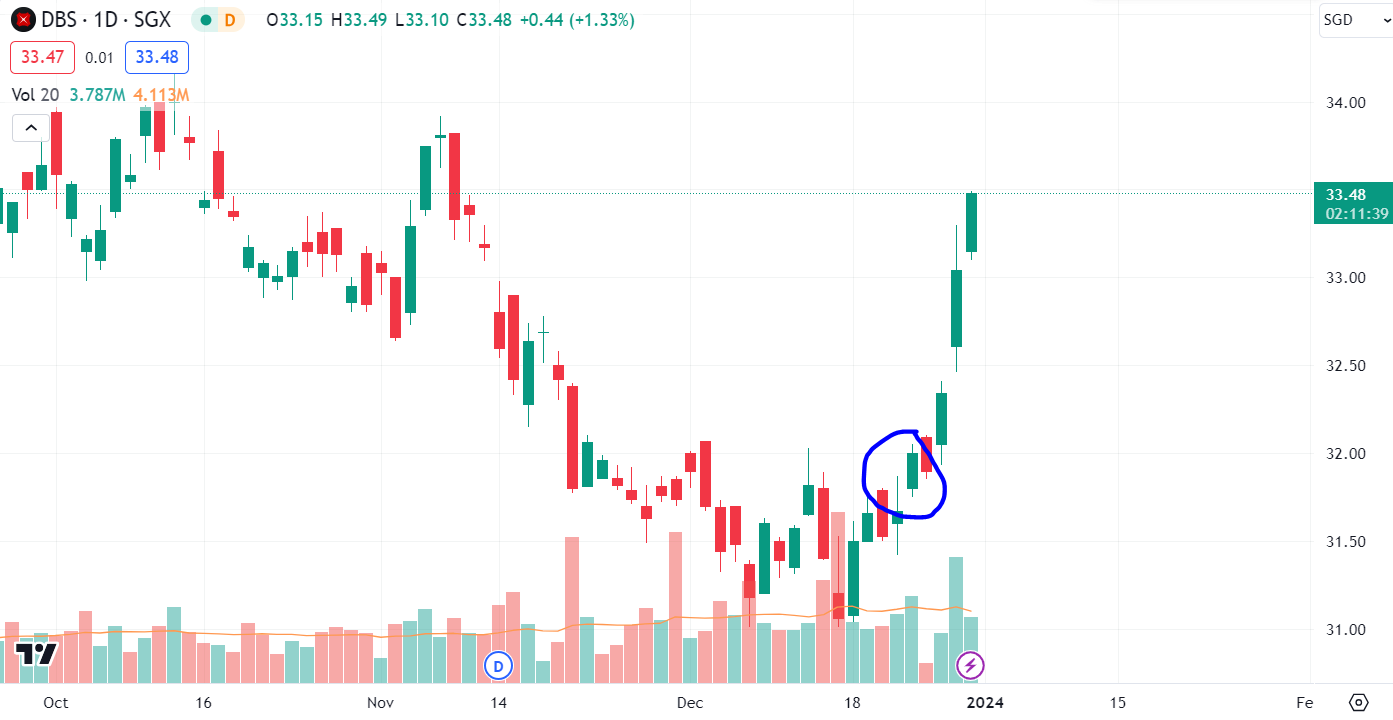
Source: tradingview.com
In Dec 2023 when a CFD trader buys 1000 shares of DBS at S$32 using CFD, he forks out S$3,200 instead of S$32,000.
As mentioned above, the commission charged is 0.1% of the contract value. The CFD trader pays a commission of S$32 (32,000 * 0.1%).
Assuming that the long financing charge for DBS is 6.75% and CFD trader holds the position over one night, the finance charge would be S$5.92 (32,000 * 6.75% / 365).
Over the next three days, the price goes up and the CFD trader liquidates his DBS CFD position on the 4th day at S$33. His commission for closing the position would be S$33 (33,000 * 0.1%).
In total, the CFD trader pays S$82.76 (S$32 + S$33 + 3 * S$5.92).
His profit would be S$33,000 – S$32,000 – S$82.76 = S$917.24.
His return on investment would be 28.7% (S$917.24 / S$3,200).
A stock trader, even with zero cost, would have a return on investment of 3.13% (S$1,000 / 32,000).
Here is a table for comparison:
| With CFD Trading | With Stock Trading | |
| Opening Position (1000 shares of DBS at S$32 ) |
S$3,200 | S$32,000 |
| Commission for opening position (0.1%) | S$32,000 * 0.1% = S$32 | Nil |
| Financing cost for 3 days | S$32,000 * 6.75% / 365 * 3 = S$17.76 |
Nil |
| Closing Position (1000 shares of DBS at S$33 ) |
S$33,000 | S$33,000 |
| Commission for closing position (0.1%) | S$33,000 * 0.1% = S$33 | Nil |
| Profit | S$33,000 – S$32,000 – S$32 -S$17.76 – S$33 = S$917.24 | S$1000 |
| Return on investment | S$917.24 / S$3,200 = 28.7% | S$1,000 / 32,000 = 3.13% |
CFD Trading - Shorting Example
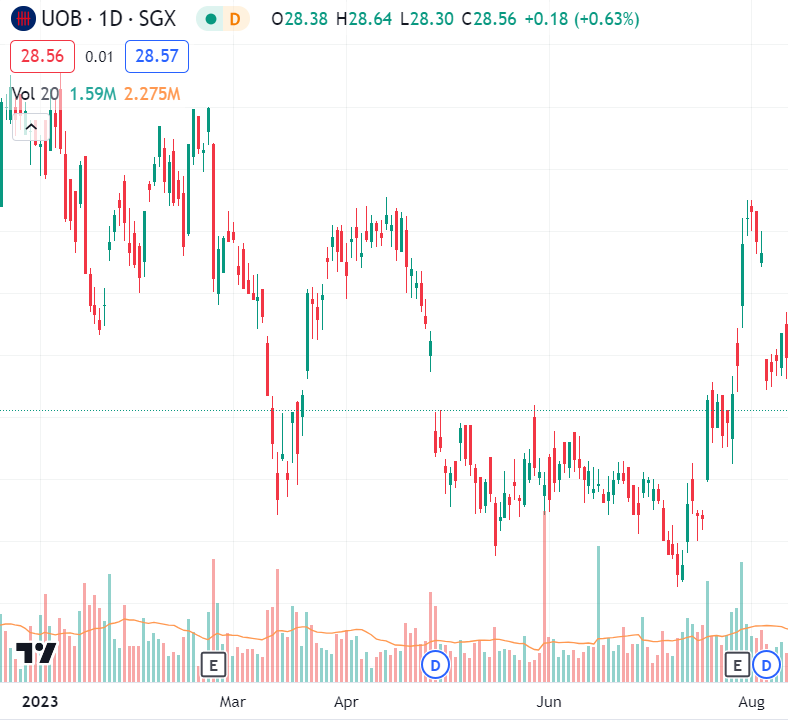
Source: tradingview.com
Around early Aug 2023, UOB announced that it was going to give dividends and hence price was likely to adjust downwards, possibly even more.
On the dividend ex-date, the price gapped down and moved up, forming a bear flag.
This presented an opportunity for a CFD trader to short UOB using CFD. The trader could easily do so with the click of a finger, without any borrowing of shares or cumbersome paperwork.
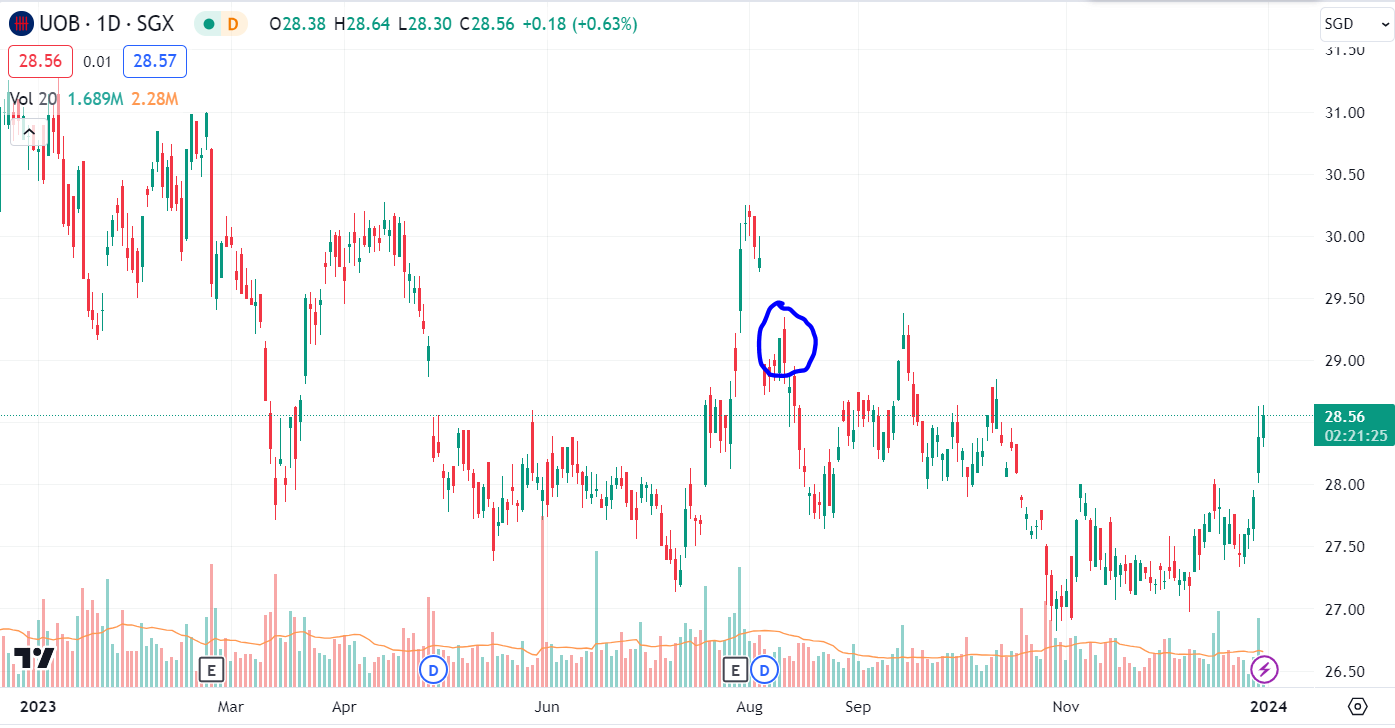
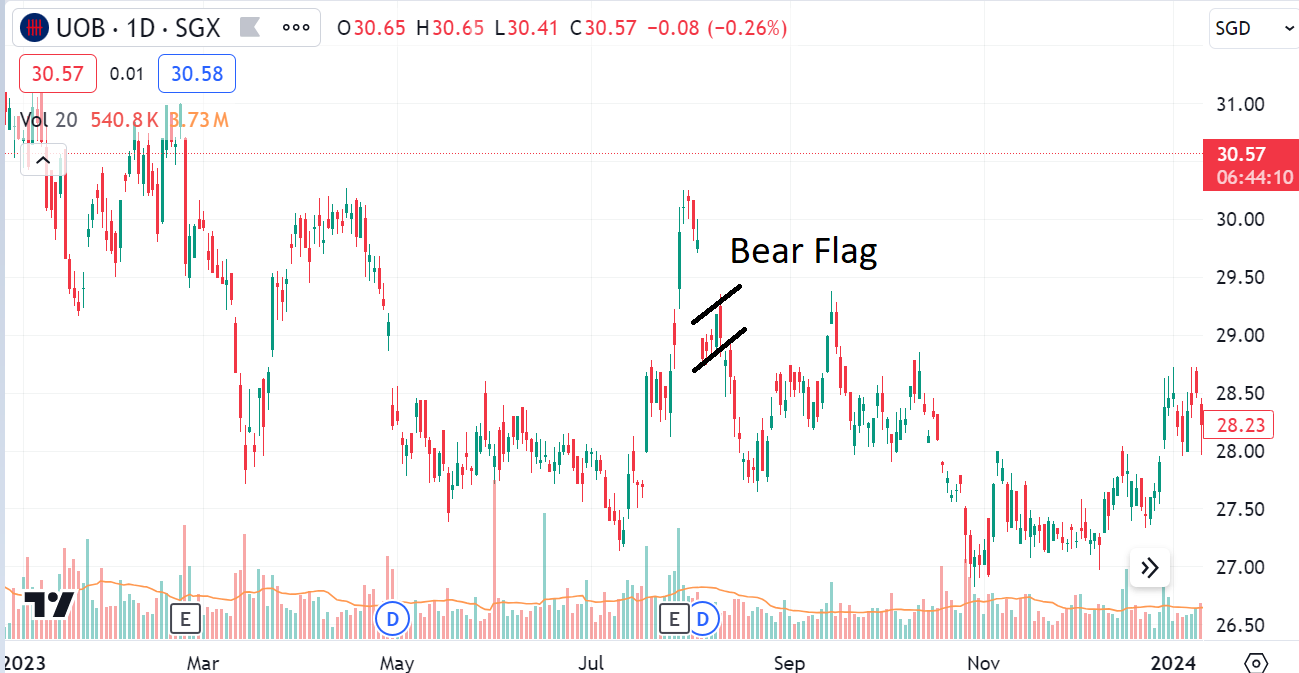
Source: tradingview.com
Assuming the CFD does so, the trade would be executed at the price of about S$29.
In this scenario, the CFD trader pays S$29,000 * 0.1% = S$29 in commission.
Assuming that the short finance charge for UOB is 3% and the CFD trader holds the position over one night, the finance charge would be S$2.38 (S$29,000 * 3% / 365).
With reference to the chart, it only took 5 days for the UOB CFD to drop to S$28, and let’s assume the CFD trader closed the position on the 6th day.
For simplicity, we will also assume the overnight charge is the same for these 5 days.
His commission for closing the position would be S$28 (S$28,000 * 0.1%).
In total, the CFD trader pays S$68.9 (S$29 + S$28 + S$2.38*5).
His profit would be S$931.10 (S$29,000 – S$28,000 – S$68.90).
His return on investment would be 32.1% (S$931.10 / S$2,900).
Of course, if price moves against you, the absolute amount lost would be the same but losses would seem amplified as your cash outlay is lower.
A stock trader, even with zero cost, would have a return on investment of 3.45% (S$1000 / S$29,000).
Here’s a table for comparison:
| With CFD Trading | With Stock Trading | |
| Opening Position (1000 shares of DBS at S$29 ) |
S$2,900 | S$29,000 |
| Commission for opening position (0.1%) | S$29,000 * 0.1% = S$29 | Nil |
| Financing cost for 3 days | S$29,000 * 3% / 365 * 3 = S$2.38 |
Nil |
| Closing Position (1000 shares of DBS at S$28 ) |
S$28,000 | S$28,000 |
| Commission for closing position (0.1%) | S$28,000 * 0.1% = S$28 | Nil |
| Profit | S$29,000 – S$28,000 – S$29 -S$11.90 – S$28 = S$931.10 | S$1000 |
| Return on investment | S$931.10 / S$2,900 = 32.1% | S$1,000 / S$29,000 = 3.45% |
Final Caution
It is important to choose a reputable broker that is regulated by the Monetary Authority of Singapore (MAS). PhillipCFD has been in operation for 20 years, with our parent company, PhillipCapital, having a history of almost half a century. At PhillipCFD, each account holder is assigned a designated dealer to provide the support you need.
Conclusion
It is important to know your objectives for trading CFDs. I have included two practical examples above and I hope you find value in them.
If you would like to learn more about CFDs, visit our website www.phillipcfd.com/learn.
If you do not have a POEMS account, you may visit here to open one with us today.
Lastly, trading within a community is much more enjoyable. You will get to interact with us and other seasoned investors who are generous in sharing their experience and expertise.
In this community, you will be exposed to quality educational materials, stock analysis to help you apply the concepts, insights into the mindset of seasoned investors, and even the opportunity to post questions.
We look forward to sharing more insights with you in our growing and enthusiastic Telegram community. Join us now!
For enquiries, please email us at cfd@phillip.com.sg.
How to get started with POEMS

POEMS’ award-winning suite of trading platforms offers investors and traders more than 40,000 financial products across global exchanges.
Trade Smarter and Faster
With our newly launched POEMS Mobile 3 Trading App
Explore a myriad of useful features including TradingView chartings to conduct technical analysis with over 100 technical indicators available!
Take this opportunity to expand your trading portfolio with our wide range of products including Stocks, CFDs, ETFs, Unit Trusts and more across 15 global exchanges available for you anytime and anywhere to elevate you as a better trader using our POEMS Mobile 3 App!
For enquiries, please email us at cfd@phillip.com.sg.
References
[1] Freepik.com
[2] Tradingview.com
More Articles
Playing Defence: Diversification in Forex Trading
Learn how strategic planning and risk management can help you navigate the highs and lows of the forex market. Don’t miss out on unlocking the secrets to long-term profitability!
From Boom to Bust: Lessons from the Barings Bank Collapse
Did you know that the collapse of Barings Bank in 1995 was from massive losses incurred by a rogue trader? Delve into the tale of how Nick Leeson’s fraudulent investments sent shockwaves through the financial world.
Japan's Economic Resurgence – Unveiling the Tailwinds Behind Nikkei 225’s Record Leap
Discover the driving forces behind Japan’s market surge, delve into its economic performance and learn how CFD products can help you navigate the Japanese market’s volatility via our article!
Disclaimer
These commentaries are intended for general circulation and do not have regard to the specific investment objectives, financial situation and particular needs of any person. Accordingly, no warranty whatsoever is given and no liability whatsoever is accepted for any loss arising whether directly or indirectly as a result of any person acting based on this information. You should seek advice from a financial adviser regarding the suitability of any investment product(s) mentioned herein, taking into account your specific investment objectives, financial situation or particular needs, before making a commitment to invest in such products.
Opinions expressed in these commentaries are subject to change without notice. Investments are subject to investment risks including the possible loss of the principal amount invested. The value of units in any fund and the income from them may fall as well as rise. Past performance figures as well as any projection or forecast used in these commentaries are not necessarily indicative of future or likely performance.
Phillip Securities Pte Ltd (PSPL), its directors, connected persons or employees may from time to time have an interest in the financial instruments mentioned in these commentaries.
The information contained in these commentaries has been obtained from public sources which PSPL has no reason to believe are unreliable and any analysis, forecasts, projections, expectations and opinions (collectively the “Research”) contained in these commentaries are based on such information and are expressions of belief only. PSPL has not verified this information and no representation or warranty, express or implied, is made that such information or Research is accurate, complete or verified or should be relied upon as such. Any such information or Research contained in these commentaries are subject to change, and PSPL shall not have any responsibility to maintain the information or Research made available or to supply any corrections, updates or releases in connection therewith. In no event will PSPL be liable for any special, indirect, incidental or consequential damages which may be incurred from the use of the information or Research made available, even if it has been advised of the possibility of such damages. The companies and their employees mentioned in these commentaries cannot be held liable for any errors, inaccuracies and/or omissions howsoever caused. Any opinion or advice herein is made on a general basis and is subject to change without notice. The information provided in these commentaries may contain optimistic statements regarding future events or future financial performance of countries, markets or companies. You must make your own financial assessment of the relevance, accuracy and adequacy of the information provided in these commentaries.
Views and any strategies described in these commentaries may not be suitable for all investors. Opinions expressed herein may differ from the opinions expressed by other units of PSPL or its connected persons and associates. Any reference to or discussion of investment products or commodities in these commentaries is purely for illustrative purposes only and must not be construed as a recommendation, an offer or solicitation for the subscription, purchase or sale of the investment products or commodities mentioned.
This advertisement has not been reviewed by the Monetary Authority of Singapore.





